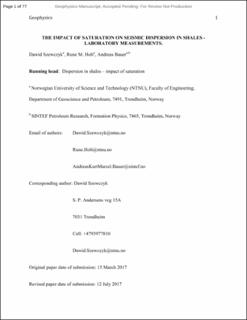The impact of saturation on seismic dispersion in shales — Laboratory measurements
Peer reviewed, Journal article
Accepted version
Date
2018Metadata
Show full item recordCollections
- Publikasjoner fra CRIStin - SINTEF AS [5801]
- SINTEF Industri [1565]
Abstract
Previous studies found a significant increase of acoustic velocities between seismic and ultrasonic frequencies (seismic dispersion) for shales, which would have to be taken into account when comparing seismic or sonic field data with ultrasonic measurements in the laboratory. We have executed a series of experiments performed with a partially saturated Mancos shale and a Pierre shale I in which the influence of water saturation on acoustic velocities and seismic dispersion was investigated. The experiments were carried out in a triaxial setup allowing for combined measurements of quasistatic rock deformation, ultrasonic velocities, and dynamic elastic stiffness at seismic frequencies under deviatoric stresses. Prior to testing, the rock samples were preconditioned in desiccators at different relative humidities. For both shale types, we present and analyze the experimental results that demonstrate strong saturation and frequency dependence of dynamic Young’s moduli, Poisson’s ratios, and Thomsen’s anisotropy parameters, as well as P- and S-wave velocities at seismic and ultrasonic frequencies. The observed effects can be attributed to water adsorption and capillary pressure that are functions of several factors including water saturation. Water adsorption results in a reduction of surface energy and grain-contact stiffness. The capillary pressure affects the effective stress and possibly also the effective pore-fluid modulus, which may be approximated by Brie’s empirical model. Reasonable fits to the low-frequency seismic data are obtained by accounting for these two effects and applying the anisotropic Gassmann model. The strong increase in dispersion with increasing water saturation is attributed to local flow involving adsorbed (bound) water, but a quantitative description is yet to be provided.
